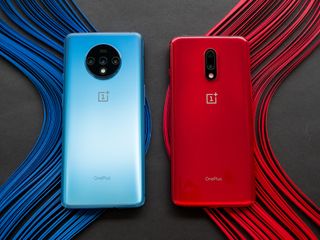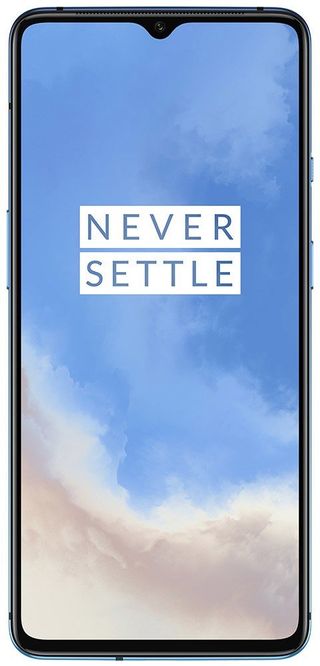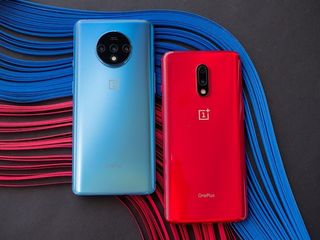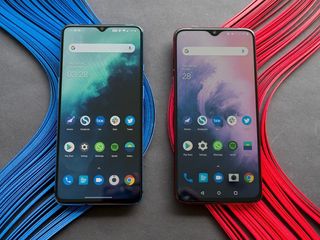OnePlus 7T vs. OnePlus 7: Which should you buy?

OnePlus 7T

The OnePlus 7T offers a similar design aesthetic as the OnePlus 7, but has big upgrades on the hardware front, including a 90Hz display. You also get Qualcomm's latest Snapdragon 855+ chipset, 30W fast charging, same great stereo sound, better haptics, and Android 10 out of the box. Couple that with a new camera housing at the back that features the same sensors from the OnePlus 7 Pro and you get an excellent overall package.
OnePlus 7T
Smooth operator
OnePlus 7

The OnePlus 7 continues to be a decent phone, but you're getting much more value in the 7T. You get more RAM and much more usable cameras at the back, but the main reason to consider the 7T over the OnePlus 7 is the 90Hz display. Once you start using a 90Hz panel, you wouldn't want to go back to a phone with a 60Hz display. You're not really saving a whole lot of money by going with the OnePlus 7, and the 7T has so much more to offer.
OnePlus 7
Outclassed
OnePlus is in the unenviable position of launching a new phone every six months. Over the last three years it has relied on a tick-tock model, with a new generation debuting in the summer that's followed by a T refresh a few months later. For 2019, there was a slight tweak to that model: OnePlus launched a more ambitious device to take on Google and Samsung with the OnePlus 7 Pro, and debuted another model alongside it with the same design as the 6T but with a 48-megapixel camera and stereo sound in the OnePlus 7. The OnePlus 7T brings solid upgrades from the OnePlus 7, so let's see what's on offer.
What's the difference between the OnePlus 7T and the OnePlus 7?
The OnePlus 7T takes over from the OnePlus 7 Pro in terms of features, with the highlight being the 90Hz panel. However, when you look at the design, it has more in common with the OnePlus 7. Both the OnePlus 7T and OnePlus 7 have nearly identical dimensions, with the 7T sporting a slightly taller design thanks to a 20:9 panel, although the OnePlus 7T comes with a host of upgrades that makes it a more enticing option.
The 90Hz display on the OnePlus 7T is an absolute delight to use.
The marquee feature this time around is the 90Hz panel. OnePlus is bringing the same high refresh rate as the OnePlus 7 Pro, but the display resolution is FHD+ (2400x1080) and not QHD+. The screen itself is flat, and there's a cutout at the top, just like the OnePlus 7. The cutout is smaller this time around, and is unobtrusive enough that you won't notice it in day-to-day usage.
The flat 90Hz display is a delight to use. I have zero issues with the fact that the resolution is just 1080p; if anything, it has led to better battery life. That 90Hz panel is plain addictive, and it's hard to go back to a regular 60Hz screen once you've made the switch. Every interaction is instantaneous, and you don't feel any lag anywhere. OnePlus mentioned it increased the speed of animations to take full advantage of the high refresh rate, and it shows.






Coming to the design side of things, the main change is the camera array at the back. The camera housing is much more prominent in the new design, and you get three sensors at the back. The 48-megapixel primary camera is the same between both phones, but the OnePlus 7T has a 12-megapixel telephoto lens and a 16-megapixel wide-angle shooter. You're also able to take videos using the wide-angle lens, and in general the addition of the two lenses makes the camera on the 7T that much more versatile.
Be an expert in 5 minutes
Get the latest news from Android Central, your trusted companion in the world of Android
The OnePlus 7T is what the OnePlus 7 should have been from the beginning.
The photos from the primary 48-megapixel shooter are identical between both devices, but the fact that you get more lenses to play with on the 7T gives it an edge in this category. The front camera continues to be a 16-megapixel Sony IMX471 module, which hasn't changed over the last two years.
The OnePlus 7T also picks up the vibration motor from the OnePlus 7 Pro, which means you get much better haptics. Another noticeable change is the fast charging: the phone offers a 30W Warp Charge 30T standard that delivers up to a 70% charge from flat in just 30 minutes. That's a sizable gain from what you get on the OnePlus 7, which still has 20W fast charging.

| Category | OnePlus 7T | OnePlus 7 |
|---|---|---|
| Operating system | Android 10 OxygenOS 10 | Android 10 OxygenOS 10 |
| Display | 6.55-inch 90Hz Fluid AMOLED 2400x1080 (20:9) HDR10+ Gorilla Glass 6 | 6.41-inch Optic AMOLED 2340x1080 (19.5:9) HDR10>Gorilla Glass 6 |
| Chipset | Snapdragon 855+ 1 x 2.96GHz Kryo 485 3 x 2.42GHz Kryo 485 4 x 1.80GHz Kryo 485 Adreno 640 7nm | Snapdragon 855 1 x 2.84GHz Kryo 485 3 x 2.41GHz Kryo 485 4 x 1.78GHz Kryo 485 Adreno 640 7nm |
| RAM | 8GB | 6GB/8GB |
| Storage | 128GB/256GB | 128GB/256GB |
| MicroSD slot | No | No |
| Rear camera 1 | 48MP, f/1.6 OIS, EIS 4K at 60fps | 48MP, f/1.6 OIS, EIS 4K at 60fps |
| Rear camera 2 | 12MP, f/2.2 OIS, 2x zoom | 5MP, f/2.4 Portrait lens |
| Rear camera 3 | 16MP, f/2.2 Wide-angle lens 117-degree field-of-view | None |
| Front camera | 16MP, f/2.0 Sony IMX471 | 16MP, f/2.0 Sony IMX471 |
| Connectivity | Wi-Fi ac 2x2 MIMO, Bluetooth 5.0 AptX HD, NFC, A-GPS | Wi-Fi ac 2x2 MIMO, Bluetooth 5.0 AptX HD, NFC, A-GPS |
| Audio | USB-C Stereo speakers | USB-C Stereo speakers |
| Battery | 3800mAh Non-removable | 3700mAh Non-removable |
| Charging | USB-C 3.1 30W | USB-C 3.1 20W |
| Water resistance | None | None |
| Security | In-display fingerprint (optical) | In-display fingerprint (optical) |
| Dimensions | 160.9 x 74.4 x 8.1mm 190g | 157.7 x 74.8 x 8.2mm 182g |
| Colors | Glacier Blue, Frost Silver | Mirror Gray, Red (China and India) |

The OnePlus 7T also offers decent upgrades on the hardware front. You get 8GB of RAM as standard — versus 6GB on the OnePlus 7 — and there's a Snapdragon 855+ under the hood. You're obviously not going to notice a lot of difference between the Snapdragon 855 and 855+, but it's all about future-proofing. And on that subject, the OnePlus 7T has a huge advantage over the OnePlus 7.
The 7T comes with Android 10 out of the box, and that means it will receive two more platform updates — Android 11 and Android 12 — over the next two years. The OnePlus 7, meanwhile, will only pick up one more platform update after Android 10.
OnePlus 7T is the ideal value flagship
With the OnePlus 7T coming so close on the heels of the OnePlus 7, the Chinese manufacturer is effectively killing off its early 2019 flagship. The OnePlus 7 launched in limited markets anyway, and it's possible OnePlus will roll out a discount to the OnePlus 7 to make the phone a more palatable option against the 7T.
If you're in the market for a value flagship, you should just get the OnePlus 7T.
Right now, the OnePlus 7T offers the ideal mix of features in this segment. The 90Hz panel gives it a huge advantage over its rivals, 30W fast charging is a nice bonus, and the hardware is on par with the best that this segment has to offer.
OxygenOS is the best third-party skin in the market today, and you get Android 10 out of the box. Sure, there's no IP rating or wireless charging, but that particular omission is forgivable when you consider just how much value you're getting here.

90Hz goodness backed by great cameras.
The OnePlus 7T should be your default choice if you're in the market for a value flagship. The 90Hz panel is a great new addition, and you get the latest Snapdragon 855+ chipset and 8GB of RAM as standard. The cameras at the back are also much more versatile than what you get on the OnePlus 7, and there's 30W fast charging.

Wait for a price correction.
At this point, the OnePlus 7 only makes sense if it gets a sizable discount for the holiday season. The OnePlus 7T has much more to offer for not that much more money, and the 90Hz panel alone is worth the added cost.

Harish Jonnalagadda is a Senior Editor overseeing Asia at Android Central. He leads the site's coverage of Chinese phone brands, contributing to reviews, features, and buying guides. He also writes about storage servers, audio products, and the semiconductor industry. Contact him on Twitter at @chunkynerd.